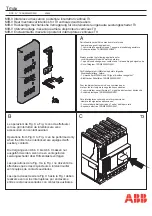
Technical data | 4
37/174
500-8384.9 • Version 11 • Installation and Operating Instructions • 8DJH
4.9 Phase sequence
The phases L1, L2 and L3 of all panel types are at the following positions:
L1
L2
L3
L3
L2
L1
Fig. 18:
Phase sequence in cable
compartment (view from the front)
Fig. 19:
Phase sequence of busbar (view
from the left)
4.10 Insulating gas
The sealed pressure system of the switchgear contains the insulating gas SF
6
(fluorinated
greenhouse gas, GWP 22,800).
Example for a typical amount of SF
6
gas:
Panel block 8DJH RRT with 2.2 kg SF
6
(CO
2
e = 50 t)
The respective amount of gas included is indicated on the rating plate of the switchgear.
Gas leakage rate
The gas leakage rate is < 0.1% per year (referred to the absolute gas pressure).
4.11 Dielectric strength and site altitude
Dielectric strength
▪ The dielectric strength is verified by testing the switchgear with rated values of short-
duration power-frequency withstand voltage and lightning impulse withstand voltage
according to IEC 62271-1/VDE 0671-1.
▪ The rated values are referred to sea level and to normal atmospheric conditions (101.3 kPa,
20 °C, 11 g/m
3
humidity according to VDE 0111 and IEC 60071).
▪ The dielectric strength decreases with increasing altitude. For site altitudes above 1000 m
(above sea level) the standards do not provide any guidelines for the insulation rating, but
leave this to the scope of special agreements.
All parts housed inside the switchgear vessel which are subjected to high voltage are insulated
against the earthed enclosure by the insulating gas.
Site altitude
The gas insulation in the switchgear vessel at a relative gas pressure of 50 kPa (= 500 hPa)
permits switchgear installation at an altitude of up to 2000 m above sea level without the
dielectric strength being adversely affected. This also applies to the cable connection when using
screened cable plugs. Site altitudes above 2000 m are possible on request.
For site altitudes of more than 1000 m (above sea level), the decrease (reduction) of the
dielectric strength must be considered for panels with HV HRC fuses and air-insulated metering
panels. For these site altitudes, a higher insulation level must be selected, which results from the
multiplication of the rated insulation level (for 0 to 1000 m) with the altitude correction
factor K
a
.
Summary of Contents for 8DJH
Page 173: ......









































